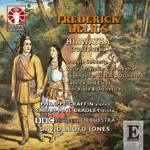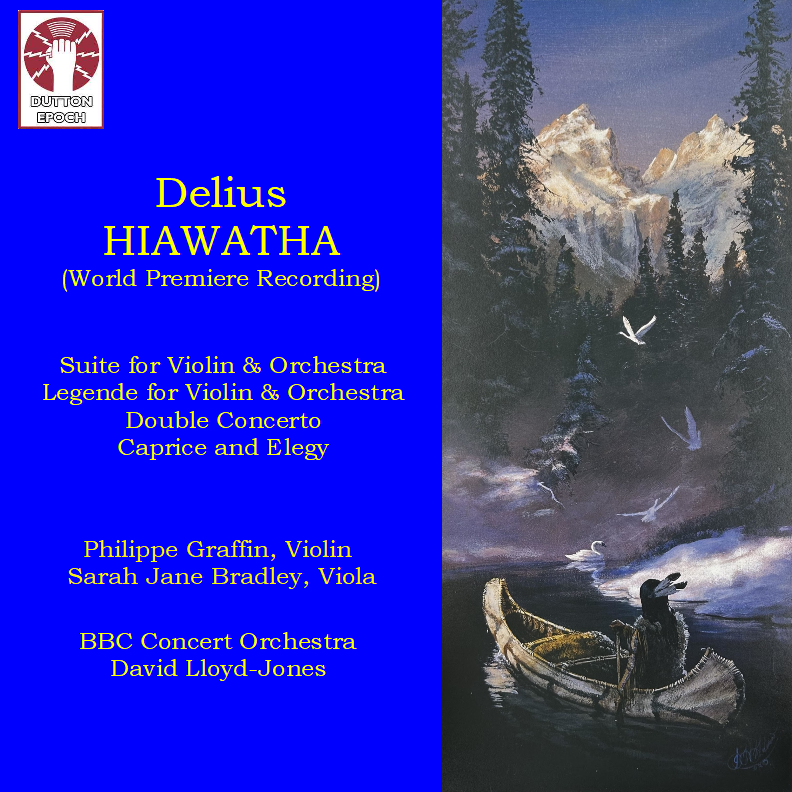 World Premiere CD Release (Dutton Epoch CDLX
7226)
World Premiere CD Release (Dutton Epoch CDLX
7226)
On the title page of the manuscript Delius quotes several lines from Longfellow -
"Ye who love the haunts of Nature,
Love the sunshine of the meadow,
Love the shadow of the forest,
Love the wind among the branches,
And the rain shower and the snow storm,
And the rushing of great rivers
Through their palisades of pine trees,
And the thunder in the mountains,
Whose innumerable echoes,
Flap like eagles in their eyries."
Artwork: "Spellbound" by Hermon
Adams
(1993)
Large scan
of
signed print
More
info
on
Hermon Adams
A performing edition of Hiawatha was
published
in
2008
as
Supplementary
Volume
6 of the Delius Collected
Edition.
Thanks to Robert Threlfall for preparing
this edition for publication.
It is available from Boosey and Hawkes.
Click here for more information.
Front cover
Sample page
 World Premiere CD Release (Dutton Epoch CDLX
7226)
World Premiere CD Release (Dutton Epoch CDLX
7226)
The BBC Concert Orchestra conducted by David
Lloyd-Jones
(The CD is
out of print, but the MP3 album is available for purchase and download
here)
CD
review
by
Rob
Barnett at MusicWeb International
My alternate cover for the
CD using the "Spellbound" painting by Hermon Adams
Hiawatha: Orchestral
Excerpt (9:47)
Norwegian Broadcasting Orchestra conducted by Sverre Bruland
This is a recording from a 1984
Norwegian television broadcast. The orchestra performed a large portion
of HIAWATHA; the
first
two sections are missing. Thanks to Dr. Andrew Joseph Boyle
for his efforts in bringing this recording into existence.
Here is more detail from Dr. Boyle about
how this recording came about:
"FROM THE HIGH SOLITUDES" ("Bakom synger fjellet") - a production of
NRK (Norwegian State Broadcasting):
The positive reception the premiere of the "Paa Vidderne" melodrama
received led Gunnar Rugstad to a new insight into the importance of
Delius. I managed to persuade the Music department to make a dramatized
documentary about Delius' strong connections and deep love for Norway.
The ambitions for the programme were considerable, but at the time the
Music Dept. had little experience in making this sort of programme and
limited financial resources. I wrote the manuscript and the
photographer Svein Bæren was put in charge of recording it.
A couple of minutes of the "Paa Vidderne" film was used in the
documentary. Of new interest was the fact that I again got the
opportunity to hear Delius music for the first time: I wrote out what
remained of the incomplete score and parts of "Hiawatha" and had these
recorded by the The Norwegian Broadcasting Orchestra. A couple of
minutes was used in the film. The conductor was Sverre Bruland. (I have
read somewhere recently that I adapted and transposed the music. This
is not true. I wrote the music out exactly as it is in the Delius
score.) The whole film lasted about 40 minutes.
NOTE: Click
here
to
access
excerpts
from
Dr.
Boyle's
thesis, which contains more
information about HIAWATHA.
This performance is not available commercially.
HIAWATHA
Orchestral Excerpt
(RealAudio
format: 1 MB) - hiawatha.ra
HIAWATHA
Orchestral
Excerpt (MP3 format: 9 MB) - hiawatha.mp3
Please E-Mail me
if you have any problems accessing these files!
Themes from Hiawatha (arr.
B.
Thompson) in MIDI format
This is an arrangement of the
melodies from HIAWATHA as described and excerpted in "The American
Sources
of Delius' Style" by Philip Jones (see below) and "Delius:
Portrait
of a Cosmopolitan" by Christopher Palmer. (NOTE: This arrangement
was prepared prior to hearing the live orchestral excerpt above.
It has been enhanced to play on wavetable sound cards.)
An Analysis of Delius' HIAWATHA by Philip Jones
Another early work showing Delius' attempt to recreate the strong impressions made on him by his American experiences is the tone poem HIAWATHA, after Longfellow's poem. According to the manuscript full score, it was completed in January 1888 and Beecham states it was begun in 1887, presumably after Delius had finished FLORIDA SUITE and was still under Grieg's supervision. Unfortunately the manuscript is now incomplete with two substantial portions of the score missing. This material must have disappeared after Beecham had finished his book, as he describes the work as being an "attempt to capture the atmosphere of wild woodland life...it is a longish piece with two main sections of a serious and flowing character divided by a sprightly dance movement."
The first three pages of the score are all that remain of the opening, yet these are fascinating because they show how strongly the pentatonic/added sixth harmony was determining the young Delius's style. HIAWATHA begins in A major and opens with the familiar tonic pedal then open fifth in the horns followed by the pentatonic melody in the muted violas with pentatonic semiquaver passage-work in the first violins, also muted. The rest of the opening is missing, but the score resumes its course on page 18, and a few bars later a very strongly defined pentatonic melody emerges in the cello section in F major. The music continues on its pentatonic way developing this melody and other associated melodies rather in the manner of FLORIDA SUITE until the score runs out before the end of the section on page 45. The score picks up again at page 54 with what must be the middle section described by Beecham above. This music begins clearly after the opening of this middle section with part of a melody in D major but the key soon returns to B minor, which is obviously the main key centre of this section, with the melody which certainly accords with Beecham's description of it as "a sprightly dance movement." This is developed at some length, alternating with a bright little D major tag which turns into a cadential phrase, which seems almost a forerunner of the SONG OF THE HIGH HILLS. The music gradually reaches a climax as the dance increases in tempo and comes to a sudden end on a chord of B minor. The last section is slow and somewhat languorous and comes to a close with a return of the "very strongly defined pentatonic melody" first heard on page 18, this time in the form of a canon with shimmering, tremolando strings. Above the ending Delius has written the following lines from Longfellow:
"Westward, westward Hiawatha
Sailed into the fiery sunset
Sailed into the purple vapors
Sailed into the dusk of evening.
Thus departed Hiawatha,
Hiawatha the Beloved,
In the glory of the sunset,
In the purple mists of evening."
It is frustrating that the work is now in an incomplete state for although, as Beecham says, Delius "was as yet only experimenting with that grand vehicle of sound, the full orchestra," it is a fascinating insight into the early development of his style.